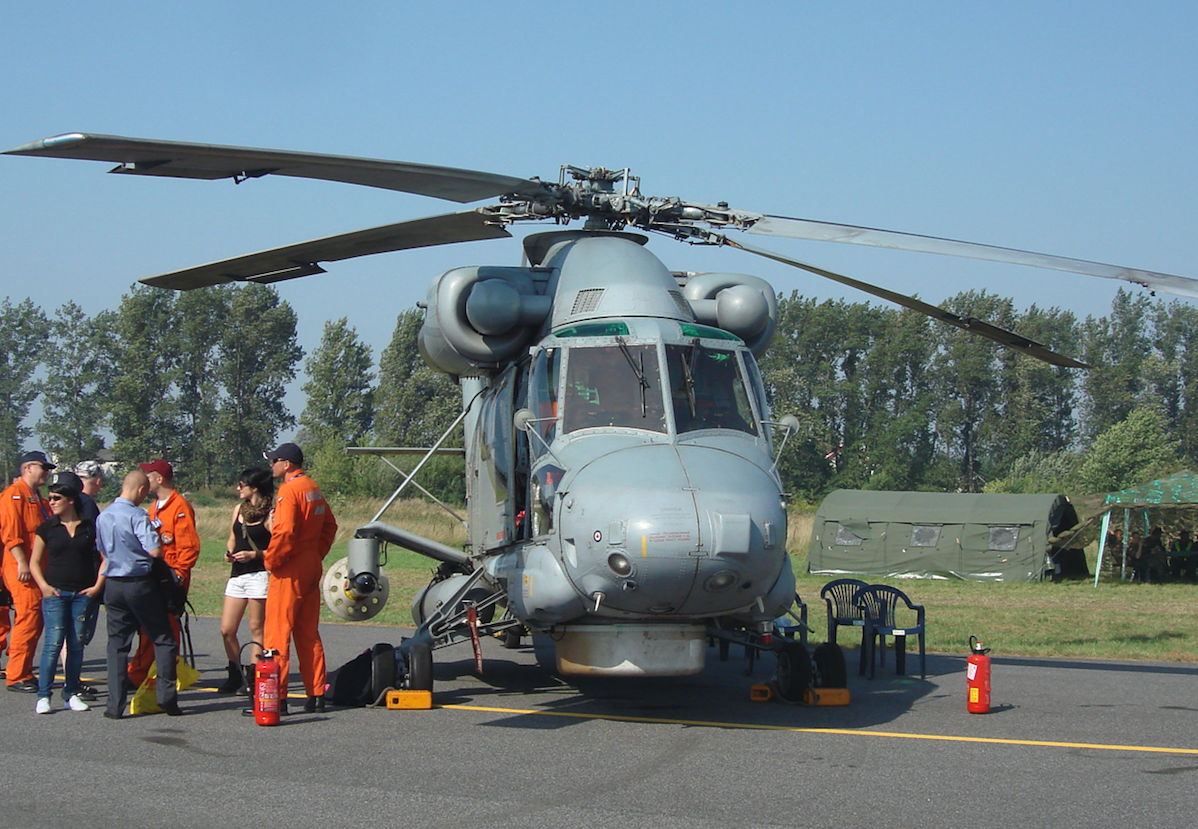Gdynia 2018-05-23
293b Rozdział 2002r.
Kaman SH-2G Super Seasprite.
Historia śmigłowca w Polsce.
Kaman SH-2 Seasprite to śmigłowiec do bazowania na okrętach, opracowany i wyprodukowany przez amerykańskiego producenta firmę Kaman Aircraft Corporation.
Rozwój śmigłowca Seasprite’a został zainicjowany pod koniec 50-lat, w odpowiedzi na zapotrzebowanie Marynarki Wojennej Stanów Zjednoczonych, żądającej odpowiednio szybkiego i niewielkiego śmigłowca morskiego do misji wojskowych. Projekt firmy Kaman, otrzymał firmowe oznaczenie K-20. Śmigłowiec został pozytywnie oceniony, co doprowadziło do zawarcia umowy na budowę czterech prototypów i pierwszej partii 12 śmigłowców produkcyjnych, oznaczonych jako HU2K-1. Pierwszy lot odbył się w dniu 2 lipca 1959 roku (HU2K-1). Wprowadzenie do służby nastąpiło w grudniu 1962 roku. Produkowany był w okresie 1959 – 1969, i zbudowano 184 sztuki.
Ze względu na niezadowalające osiągi, od 1968 roku, UH-2 amerykańskiej marynarki wojennej zostały zmodyfikowane poprzez wymianę zespołu napędowego, z pojedynczego silnika, do mocniejszej dwusilnikowej konfiguracji. W październiku 1970 roku, Seasprite została wybrana przez US NAVY jako platforma dla śmigłowca Light Airborne Multi-Purpose System (LAMPS), co spowodowało, że opracowano i zainstalowano znacznie ulepszone systemy ochrony przed atakiem podwodnym i nawodnym, w nowym wariancie typu, oznaczonego jako SH-2F. W 70- i 80-latach XX wieku, większość istniejących śmigłowców UH-2 została zmodernizowana do ulepszonego modelu SH-2F.
Kaman SH-2G Super Seasprite.
Kaman SH-2G Super Seasprite został pierwotnie opracowany dla amerykańskiej marynarki wojennej w 1980 roku, jako głęboka modernizacja wersji starszego Kaman SH-2 Seasprite. W 1985 roku uruchomiono program wersji SH-2G. Marynarka wojenna USA chciała uzyskać lepsze możliwości zwalczania okrętów podwodnych i uważała, że modernizacja obecnych śmigłowców była bardziej opłacalnym podejściem do tematu. Prototyp YSH-2G pierwszy odbył się 2 kwietnia 1985 roku. Prototypem był zmodyfikowany SH-2F wyposażony w dwa mocniejsze silniki General Electric T700-GE-401 / 401C.
Model G ma wzmocniony górny kadłub do montażu nowych, cięższych silników. SH-2G ma również wielofunkcyjne wyświetlacze i nowe systemy awioniczne. Kaman SH-2G Super Seasprite był produkowany w latach 1985 – 1995.
Głównymi misjami śmigłowców SH-2G są walki z okrętami podwodnymi i nawodnymi, obrona przeciwrakietowa oraz nadzór i ochrona statków. Drugorzędne misje mogą obejmować ewakuację medyczną, poszukiwanie i ratowanie, transport żołnierzy i ładunków, a także dozór połowów, amfibijne wsparcie powietrzne, wykrywanie pożarów, wykrywanie min i ocenę efektów walk, czy klęsk żywiołowych. Śmigłowiec SH-2G może być wyposażony w różne uzbrojenie. Może przenosić różne rodzaje broni, takie jak pociski przeciwpancerne AGM-119B Penguin, rakiety powietrze-ziemia MaMaster z serii AGM-65 Maverick oraz torpedy Mk.50. Śmigłowiec ma standardowo dwa karabiny maszynowe, różnych typów, takie jak działo M60 lub M134 Gatling.
SH-2G napędzany jest przez dwa silniki turbowałowe T700-GE-401, o mocy 2 x 1,723 shp (2 x 1 285 kW). W przypadku awarii lub uszkodzenia, śmigłowiec może latać z jednym silnikiem. Łopaty wirnika mają zredukowane drgania, co zapewnia dłuższą żywotność komponentów i mniejsze zmęczenie członków załogi. Cechą tego śmigłowca jest możliwość tankowania w locie.
Kadłub tego śmigłowca został specjalnie zaprojektowany do operacji morskich. Łopaty wirnika są składane, aby ułatwić hangarowanie na okrętach. Śmigłowiec ma wyrzutnik flar i dipoli, system tłumienia pożarów. Pilot i operator taktyczny siedzą na absorbujących energię, wytrzymałych fotelach. Istnieją również awaryjne urządzenia pływające, tratwy ratunkowe. Zmodernizowany śmigłowiec SH-2G wykorzystuje nowoczesne komercyjne gotowe do użycia systemy i wyposażenie okrętowe, takie jak zintegrowany szklany kokpit, cyfrowy automatyczny system sterowania lotem, nowoczesne systemy nawigacyjne i komunikacyjne. Ten śmigłowiec może działać w dzień i w nocy oraz w trudnych warunkach atmosferycznych.
Kaman SH-2G Super Seasprite w Polsce.
Po przystąpieniu Polski do NATO w dniu 12 marca 1999 roku, musieliśmy wykonać sojusznicze zobowiązania. Należało wzmocnić siłę bojową Marynarki Wojennej. Jednym z elementów było wprowadzenie do uzbrojenia nowych śmigłowców bojowych. W 2002 roku, spośród egzemplarzy SH-2 G składowanych w bazie statków powietrznych AMARC w Davis-Monthan w Arizonie wybrano cztery śmigłowce.
Były to śmigłowce SH-2 G, które pochodziły z ostatnich lat produkcji (1995 rok): Pierwszy Nb 163543 Nr 247. Drugi Nb 163544 Nr 248. Trzeci Nb 163545 Nr 249. Czwarty Nb 163546 Nr 250.
Wytypowane śmigłowce skierowano do remontu w zakładach Kaman Aerospace w Bloomfield. Śmigłowce również doposażono do pełnienia niektórych misji bojowych. We wrześniu 2002 roku, dwa śmigłowce dostarczono do Polski, transportem morskim do Niemiec, a następnie lotem do Gdyni. Razem ze śmigłowcami przybyła grupa Amerykańskich instruktorów. W październiku 2002 roku, dostarczono kolejne dwa śmigłowce. Miejscem stacjonowania śmigłowców jest lotnisko w Babich Dołach, z uwagi na bliskość portu wojennego na Oksywiu. Polscy lotnicy szybko opanowali polotaż nowych śmigłowców, co było zaskoczeniem dla Amerykańskich instruktorów.
Marynarka Wojenna RP eksploatuje cztery śmigłowce Kaman SH-2G Super Seasprite, które zostały zakupione w ramach dwóch fregat typu Oliver Hazard Perry z amerykańskiej marynarki wojennej. Fregaty działają teraz jako ORP Generał Tadeusz Kościuszko i Generał Kazimierz Pułaski. W 2007 roku zmodyfikowano je tak, aby mogły być wyposażone w jedną torpedę MU90 Impact i karabin maszynowy 7,62 mm PK na stanowisku obrotowym.
W dniu 25 października 2002 roku, przy Skwerze Kościuszki w Gdyni, nowe śmigłowce pokazano społeczeństwu miasta. Dwa śmigłowce wystartowały z pokładu fregaty, wykonały kilka przelotów przed publicznością i odlecały do bazy. Załogi śmigłowców były mieszane: Polsko – Amerykańskie.
Warto zaznaczyć, że polscy technicy szklenie obsługi śmigłowców odbyli w zakładach Kaman Aerospace w Bloomfield, ponieważ w 2002 roku, żadna jednostka bojowa w USA nie użytkowała już tych śmigłowców. Śmigłowce SH-2 G stanowiły zapas sprzętu na wypadek wojny.
Z początkiem 2003 roku, pierwsze Polskie załogi otrzymały certyfikaty uprawniające do lotów w pełnym zakresie. Certyfikaty wręczył ambasador USA w Polsce, pan Christopher Hill. Już po kilku tygodniach, dowódcy załóg śmigłowców otrzymali uprawnienia instruktorów. W 2003 roku, jeden śmigłowiec SH-2 G zaprezentowano na pokazach Air Show w Radomiu.
Opracował Karol Placha Hetman



